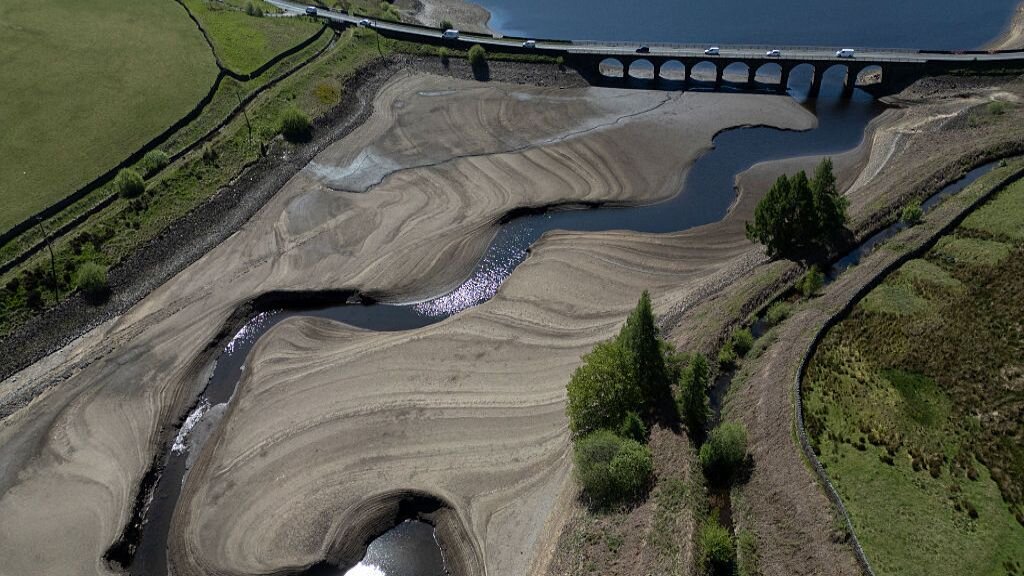
UK Faces Potential Water Crisis as River Levels Decline
Drought conditions persist amid the driest spring in over six decades, leading to agricultural concerns and potential water restrictions.
Many rivers across the United Kingdom are currently experiencing exceptionally low water levels, exacerbated by a drought that has been characterized as the driest spring in England since 1961.
The Centre for Ecology & Hydrology (CEH) predicts that these low levels could worsen over the next three months, raising significant concerns regarding water supplies for households, agriculture, and industries.
Forecasts indicate that nearly all regions in the UK will encounter below-normal or low river levels in May 2025, with the exception of the south-west of England and parts of southern Wales.
The Environment Agency has issued a statement warning of a medium risk of drought and has cautioned households about potential water restrictions in the near future.
Mark Owen, head of fisheries for the Angling Trust and a member of the National Drought Group, described the coming weeks as "crucial" for determining the onset of formal drought conditions.
While the country is not currently classified as being in drought, the adverse effects of the prolonged dry weather are already becoming apparent, particularly in agriculture.
Farmers, such as Nick Deane from Norfolk, have reported being compelled to irrigate their fields as early as March, a practice typically reserved for later in the year.
Deane has indicated that crop irrigation has become necessary to maintain yields, and he expressed concern about prolonged drought leading to increased imports to meet food demand.
The current dry conditions have already led to a marked increase in the area of the UK affected by wildfires this year.
The last significant drought in the UK occurred between June and August of 2022, coinciding with record-high temperatures and low rainfall, resulting in five water companies implementing hosepipe bans that affected 19 million residents.
Prior to that, a six-month stretch of dry conditions had been recorded.
However, the unusually wet summer in 2024 and moderate winter provided a more favorable water supply situation, with companies now relying on larger reserves.
Despite these reserves, experts warn that the current dry weather pattern poses risks for future water availability, particularly if low rainfall continues.
Stephen Turner, a hydrologist at the UK Centre for Ecology and Hydrology, highlighted that early dry conditions could impact water resource management later in the year.
Richard Thompson, chair of the National Drought Group, has indicated that if the dry conditions persist, water companies may be forced to implement restrictions to safeguard water supplies.
Critical questions now revolve around upcoming rainfall patterns and the potential for substantial precipitation.
Variability in rainfall impacts regional water supply dynamics.
The southern regions of England tend to take longer to transition into drought conditions and similarly to recover due to the geological factors that influence underground water storage.
In contrast, the northern regions experience a quicker cycle of drought onset and recovery.
Water companies have established guidelines for introducing hosepipe bans when internal water levels reach certain thresholds.
In situations of severe drought, the government has the authority to restrict agricultural irrigation, limit navigation on waterways, and could, in extreme circumstances, ration water for households and businesses—a measure not taken since 1976.
The water industry, alongside the National Farmers' Union (NFU), has been advocating for increased governmental support to secure water supplies in the most affected regions.
Water UK has proposed the creation of a national water grid designed to transport water from regions with surplus to those experiencing shortages.
Farmers are calling for additional government funding and reduced planning restrictions to facilitate the construction of their own reservoirs.
For instance, Nick Deane collaborated with five other farmers to establish a reservoir capable of holding 270,000 cubic meters of water, a project that took four years and cost over £1 million.
Initially viewed as vital, the group reported that 15% of their stored water has already been utilized due to this year's dry conditions.
A government spokesperson noted ongoing efforts to enhance water supply resilience, in collaboration with the agricultural sector, alongside significant private investment aimed at bolstering essential water infrastructure.
This includes the development of nine new reservoirs to secure future water supply.
The observed dry weather phenomena, attributed to persistent high-pressure systems, have raised inquiries about potential links to climate change.
While scientists continue to investigate these connections, projections suggest an increase in both the frequency and duration of extreme weather events, including droughts, in the UK.
The Met Office anticipates that changing climatic conditions could lead to more severe hydrological impacts and challenges for water resource management in the future.
The Centre for Ecology & Hydrology (CEH) predicts that these low levels could worsen over the next three months, raising significant concerns regarding water supplies for households, agriculture, and industries.
Forecasts indicate that nearly all regions in the UK will encounter below-normal or low river levels in May 2025, with the exception of the south-west of England and parts of southern Wales.
The Environment Agency has issued a statement warning of a medium risk of drought and has cautioned households about potential water restrictions in the near future.
Mark Owen, head of fisheries for the Angling Trust and a member of the National Drought Group, described the coming weeks as "crucial" for determining the onset of formal drought conditions.
While the country is not currently classified as being in drought, the adverse effects of the prolonged dry weather are already becoming apparent, particularly in agriculture.
Farmers, such as Nick Deane from Norfolk, have reported being compelled to irrigate their fields as early as March, a practice typically reserved for later in the year.
Deane has indicated that crop irrigation has become necessary to maintain yields, and he expressed concern about prolonged drought leading to increased imports to meet food demand.
The current dry conditions have already led to a marked increase in the area of the UK affected by wildfires this year.
The last significant drought in the UK occurred between June and August of 2022, coinciding with record-high temperatures and low rainfall, resulting in five water companies implementing hosepipe bans that affected 19 million residents.
Prior to that, a six-month stretch of dry conditions had been recorded.
However, the unusually wet summer in 2024 and moderate winter provided a more favorable water supply situation, with companies now relying on larger reserves.
Despite these reserves, experts warn that the current dry weather pattern poses risks for future water availability, particularly if low rainfall continues.
Stephen Turner, a hydrologist at the UK Centre for Ecology and Hydrology, highlighted that early dry conditions could impact water resource management later in the year.
Richard Thompson, chair of the National Drought Group, has indicated that if the dry conditions persist, water companies may be forced to implement restrictions to safeguard water supplies.
Critical questions now revolve around upcoming rainfall patterns and the potential for substantial precipitation.
Variability in rainfall impacts regional water supply dynamics.
The southern regions of England tend to take longer to transition into drought conditions and similarly to recover due to the geological factors that influence underground water storage.
In contrast, the northern regions experience a quicker cycle of drought onset and recovery.
Water companies have established guidelines for introducing hosepipe bans when internal water levels reach certain thresholds.
In situations of severe drought, the government has the authority to restrict agricultural irrigation, limit navigation on waterways, and could, in extreme circumstances, ration water for households and businesses—a measure not taken since 1976.
The water industry, alongside the National Farmers' Union (NFU), has been advocating for increased governmental support to secure water supplies in the most affected regions.
Water UK has proposed the creation of a national water grid designed to transport water from regions with surplus to those experiencing shortages.
Farmers are calling for additional government funding and reduced planning restrictions to facilitate the construction of their own reservoirs.
For instance, Nick Deane collaborated with five other farmers to establish a reservoir capable of holding 270,000 cubic meters of water, a project that took four years and cost over £1 million.
Initially viewed as vital, the group reported that 15% of their stored water has already been utilized due to this year's dry conditions.
A government spokesperson noted ongoing efforts to enhance water supply resilience, in collaboration with the agricultural sector, alongside significant private investment aimed at bolstering essential water infrastructure.
This includes the development of nine new reservoirs to secure future water supply.
The observed dry weather phenomena, attributed to persistent high-pressure systems, have raised inquiries about potential links to climate change.
While scientists continue to investigate these connections, projections suggest an increase in both the frequency and duration of extreme weather events, including droughts, in the UK.
The Met Office anticipates that changing climatic conditions could lead to more severe hydrological impacts and challenges for water resource management in the future.











